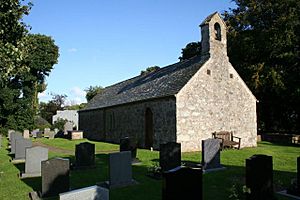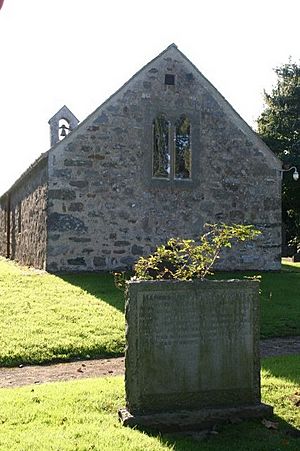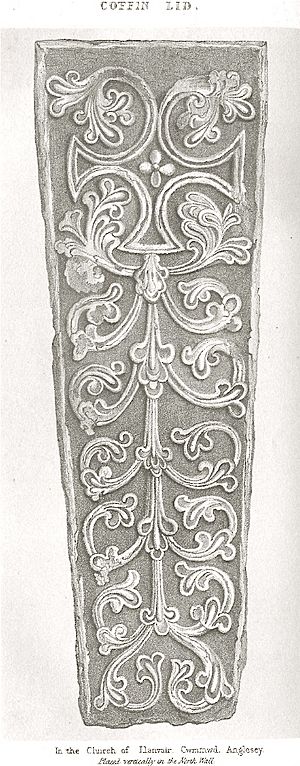St Mary's Church, Llanfair-yn-y-Cwmwd facts for kids
Quick facts for kids St Mary's Church, Llanfair-yn-y-Cwmwd |
|
|---|---|

The west end of the church
|
|
| Lua error in Module:Location_map at line 420: attempt to index field 'wikibase' (a nil value). | |
| OS grid reference | SH 4470 6676 |
| Location | near Dwyran, Anglesey |
| Country | Wales, United Kingdom |
| Denomination | Church in Wales |
| Website | Parish website |
| History | |
| Status | Parish church |
| Founded | Probably 15th century |
| Dedication | St Mary |
| Architecture | |
| Functional status | Active |
| Heritage designation | Grade II* |
| Designated | 30 January 1968 |
| Architect(s) | Harold Hughes and William G. Williams (1936 repairs) |
| Architectural type | Church |
| Style | Medieval |
| Specifications | |
| Length | 47 ft (14.3 m) |
| Width | 14 ft (4.3 m) |
| Materials | Rubble masonry |
| Administration | |
| Parish | Newborough with Llanidan with Llangeinwen and Llanfair-yn-y-Cymwd |
| Deanery | Tindaethwy and Menai |
| Archdeaconry | Bangor |
| Diocese | Diocese of Bangor |
| Province | Province of Wales |
St Mary's Church, Llanfair-yn-y-Cwmwd is a small, old church located near the village of Dwyran in Anglesey, north Wales. It was likely built in the 1400s. This church is special because it still has many of its original features.
Inside, you can find a stone font from the 1100s and a decorated coffin lid from the 1200s. The church bell is also very old, made in 1582. A famous person, Maurice Wilks, who helped invent the Land Rover, is buried in the churchyard.
Even though the church was once in poor condition, it was repaired and is still used for worship today. It's part of the Church in Wales and holds services once a month from April to September. St Mary's is a "Grade II* listed building," which means it's a very important historical building. It's considered a great example of an old church that hasn't been changed too much over time.
Contents
Church History and Location
St Mary's Church is in a quiet countryside area, about 100 yards from the main road. It's near the village of Dwyran in Anglesey, north Wales. The church is about 5.5 miles from Llangefni, a larger town.
The name "Llanfair-yn-y-Cwmwd" tells us a bit about the church. In Welsh, "llan" means "church," and "fair" comes from "Mair," which is Welsh for "Mary." So, it's "St Mary's Church." "Cwmwd" refers to an old Welsh land division.
Historians believe the church was built in the 15th century (the 1400s). Some parts might even be older. In the 1500s, new stone supports were added to the windows. The roof was also updated around that time.
In the early 1800s, the church was in such bad shape that services couldn't be held there. However, it was repaired. Compared to many other old churches in Anglesey, St Mary's kept most of its original look. More repairs were done in 1936.
Who Used the Church?
St Mary's was once one of several smaller churches connected to a larger church called St Nidan's. These churches were looked after by a group of monks called Augustinians from a place called Beddgelert. It's a mystery how these distant monks came to own churches in Anglesey!
Today, St Mary's Church is still an active place of worship for the Church in Wales. Services are held once a month from April to September. It's part of a group of five churches that share a priest.
Famous People Connected to St Mary's
One important person linked to the church was Henry Rowlands. He was a priest here from 1696 until 1723 and wrote a history book about Anglesey.
Another notable person is Maurice Wilks, who helped create the famous Land Rover. He lived on a farm nearby, and some of the first Land Rovers were even tested in Anglesey. He is buried in the churchyard.
Church Design and Features
The church is built from rough stone with smoother sandstone pieces. It measures about 47 feet long and 14 feet wide. You enter the church through a door on the north side. The roof is made of slate and has a small bell tower at the west end.
The bell in the tower was made in 1582. It has a special design, including a fleur-de-lys (a lily symbol) and the letters "AMN" repeated three times.
Inside, the church has one main open space. There's a wooden screen with iron gates from the 1800s that separates the main area (the nave) from the altar area (the chancel). The floor near the altar has colorful tiles. The wooden roof beams are visible, showing how the church was built.
Windows and Decorations
The church has several windows. There's one in the middle of the north wall and two pairs of windows on the south wall. The window at the east end has two sections with a three-leaf pattern at the top.
The font, used for baptisms, is at the west end of the church. It's made of stone and dates back to the 12th century (the 1100s). It has a zig-zag pattern and crosses carved into it. The base of the font has carved human heads and a snake design.
A very old coffin lid from the 13th century (the 1200s) is displayed on the north wall. It's decorated with a carved cross and leaf patterns. There are also other old coffin lids on the church floor and in the churchyard. You can also see memorials from the 18th, 19th, and 20th centuries inside.
Why St Mary's Church is Important
St Mary's Church is a "Grade II* listed building." This is the second-highest level of protection for historic buildings in Wales. It means the church is very important and special. It received this status on January 30, 1968.
It's listed because it's a great example of a simple, old church from the late Middle Ages that hasn't been changed much. Many other old churches in Anglesey were rebuilt or heavily repaired in the 1800s. St Mary's is special because it kept its original character.
In 1846, a historian named Harry Longueville Jones said St Mary's was one of the smallest churches on the island. He noted that the old font was "one of the most remarkable" in Anglesey. Another historian in 1929 called the coffin lid one of the best examples of old memorials in the area.
A guide from 2006 describes St Mary's as "a good example of a small unspoilt country church." It highlights the simple screen inside and the well-kept churchyard.



